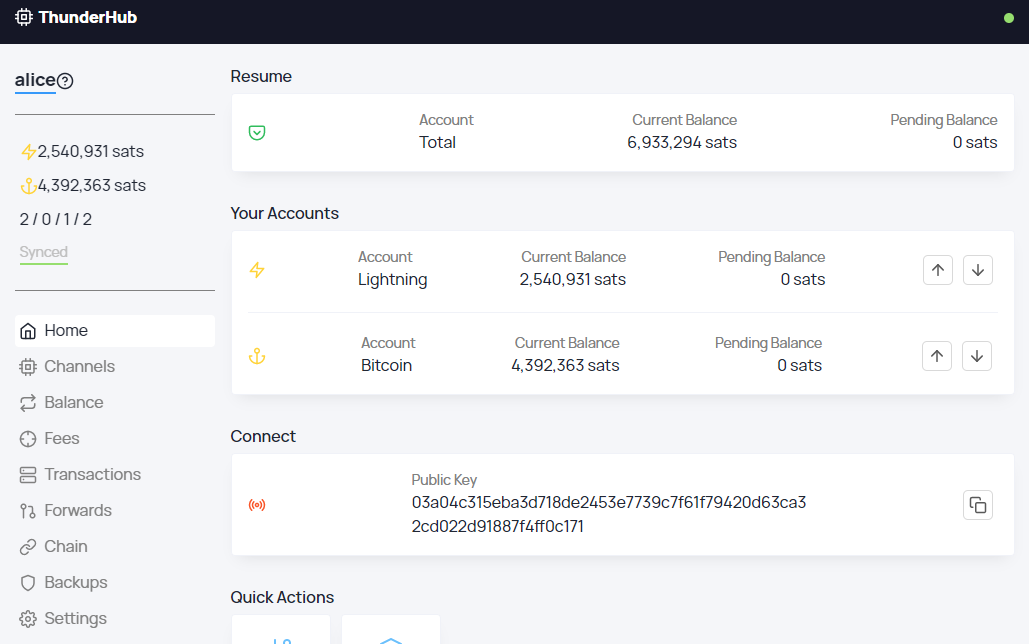| assets | ||
| client | ||
| docs | ||
| server | ||
| docker-compose.yml | ||
| LICENSE | ||
| README.md | ||
ThunderHub - Lightning Node Manager
Table Of Contents
Introduction
ThunderHub is an open-source LND node manager where you can manage and monitor your node on any device or browser. It allows you to take control of the lightning network with a simple and intuitive UX and the most up-to-date tech stack.
Tech Stack
Client
- ReactJS
- Typescript
- Styled-Components
- Apollo
Server
- Apollo-Server
- GraphQL
- Ln-Service
Features
Monitoring
- Overview of current and pending balance for the Lightning and Bitcoin wallets.
- URI strings for the node (Onion public uri also if available)
- Invoice and Payment graph.
- Liquidity report with total remote and local lightning balance.
- Forwarded payments graph and the routes used for these payments.
- Complete network info.
- View open/pending/closed channels and how balanced they are.
- View channel base and rate fees.
- View all transactions.
- View all forwarded payments.
- View all chain transactions.
Management
- Send and Receive Lightning payments.
- Send and Receive Bitcoin payments.
- Decode lightning payment requests.
- Open and close channels.
- Balance your channels through circular payments. (Check out the Tutorial)
- Update your all your channels fees or individual ones.
- Backup, verify and recover all your channels.
Visual
- Responsive UI for any device. Mobile, Tablet or Desktop.
- Light and Dark mode.
- Check values in Bitcoin, Satoshis or Fiat.
Accounts
- Many ways to connect to your node: HEX/Base64 strings, LNDConnect Url, BTCPayServer Info or QR codes.
- Have view-only and/or admin accounts.
- Manage up to 10 different nodes.
- Quickly sync your accounts between devices. No need to copy/paste macaroons and certificates.
Future Features
- Loop In and Out to provide liquidity or remove it from your channels.
- Docker Image for easy deployments.
Installation
To run ThunderHub you first need to clone this repository.
git clone https://github.com/apotdevin/thunderhub.git
Requirements
- Node installed
- Yarn or NPM installed
After cloning the repository, go into both the /client and the /server folders, and run yarn or npm install in both of them to get all the necessary modules installed.
ThunderHub - Server
To get the server running use the following commands
This must be done in the /server folder
//With yarn:
yarn build
yarn start
//With npm:
npm run build
npm run start
If the server starts succesfully, you should see info [server.js]: Server ready at http://localhost:3001/ in the terminal
ThunderHub - Client
To get the React frontend running use the following commands
This must be done in the /client folder
//With yarn:
yarn start
//With npm:
npm run start
If the frontend starts succesfully, you should see Compiled successfully! You can now view app in the browser. in the terminal and a browser window should have opened in your browser.
Development
If you want to develop on ThunderHub and want hot reloading when you do changes use the following commands
ThunderHub - Server
//With yarn:
yarn build:dev
// In another terminal
yarn dev
//With npm:
npm run build:dev
// In another terminal
npm run dev
ThunderHub - Client
Running the commands yarn start or npm run start works for development.
You can also get storybook running for quicker component development.
//With yarn:
yarn storybook
//With npm:
npm run storybook

